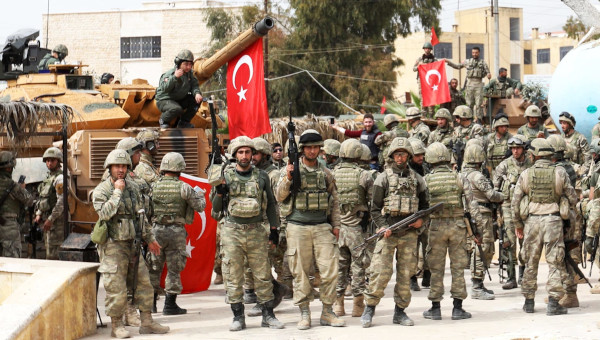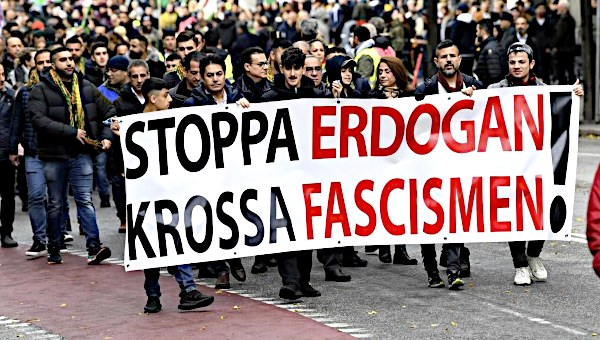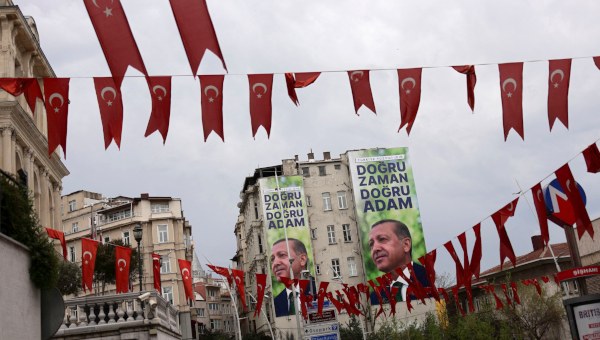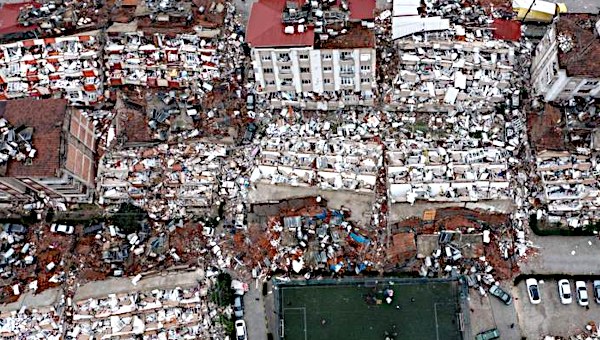May 31 was the anniversary of the eruption of the popular rebellion in Turkey that has gone under the name of Gezi Park around the world. On that anniversary, a virtual state of emergency was established in Istanbul, with 25,000 police officers deployed around Taksim Square, the political, cultural and tourism centre of Istanbul, where the AKP government’s plan to build a shopping mall in place of the park siding the square was frustrated by the revolt in 2013. Tear gas poisoning the atmosphere, people fainting, gas canisters targeted at demonstrators’ heads, one Italian journalist injured by a hit on his chest, a CNN International correspondent taken under custody while on air, an opposition MP almost being strangled by the police – all that Turkey has become accustomed to in recent years in terms of state repression and police brutality.
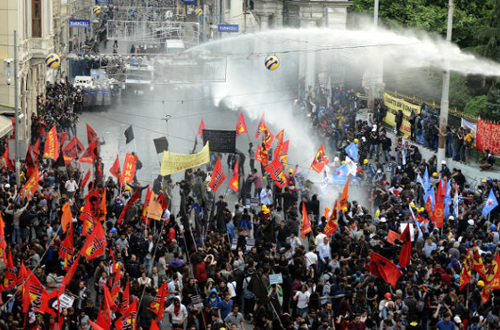
Alliance Contre Nature
For one thing, the mainstream left has tried to cash in on the popular revolt by forming a broad electoral front with bourgeois forces at the local elections of March 30 this year and defeating prime minister Tayyip Erdoğan at the ballot box. Apart from proving futile, since the ballot box is Erdoğan’s strongest side, this has led to a kind of lulling of the consciousness of the masses and a loss of the self-confidence of the movement. On the other hand, the popular revolt that was triggered by Gezi involved a broad coalition of forces and one significant element has now abandoned the coalition. This is the Turkish nationalist tendency that sided with the so-called “deep state,” i.e. the centre from which both the dirty warfare of the 1990s against the Kurds and the successive coup plots against the AKP government were organized (as all mass phenomena, Gezi was a complex creature!). This is because this force came to an understanding with Erdoğan during his weakest moment and, in return for the release of the generals imprisoned by Erdoğan’s judges for years now, has softened its criticism. This alliance contre nature cannot last long, but it has served as a life buoy for Erdoğan so far and that is what counts.
So the popular revolt cannot, in all probability, rise up as a re-edition of its former self. What it needs is a source of rejuvenation from a different quarter. The most obvious candidate here is, of course, the working-class. But in recent years that formidable force has been going through a period of prolonged lull, except for the impressive fight put up in 2010 by the workers of Tekel, the state monopoly of tobacco and alcohol. However, the struggles of the recent period suggest that a change may be coming. And here the events that unfolded in the wake of the mining disaster of May 13 in the Western Anatolian town of Soma may prove to be of decisive importance. In order to be able to assess the importance of Soma, we need to situate it in the concrete context in which Turkey finds itself at this moment.
The Legacy of the Gezi Rebellion
Tayyip Erdoğan and his party, the neoliberal Islamist AKP, have been in power for the last twelve years with a very strong majority in parliament, just short of the two thirds that is necessary to amend the constitution. In those dozen years, Erdoğan has been able to beat back all the forces countering him (the two major opposition parties, one a self-styled social-democratic party and the other of a plainly fascist legacy, the armed forces, the anti-Islamist media, the high judiciary etc.), except for one: the Kurdish national liberation movement in the south-eastern and eastern regions of the country, which has been waging a guerrilla war since 1984. Lately, Erdoğan has turned to an alliance with the Kurdish movement in an agreement euphemistically called “the solution process,” pretending that he is trying to put an end to the war that has taken close to 40,000 lives on the two sides in three decades. Having quieted the Kurdish movement as well, he has been expressly aiming for the presidential seat until 2023, the centenary of the republic of Turkey.
It is against this background of victorious march forward for Erdoğan that one has to understand the immense importance of the popular rebellion triggered by the Gezi events. This episode was the first setback for a politician with a spotless record. Not only for the sheer strength of the movement: according to official statistics, close to three and a half million people came out to protest in 80 provinces out of the 81 in the country; Taksim Square was under the occupation of the demonstrators between June 1-15, with a commune-like structure and a common kitchen in a tent-city that harboured tens of thousands of people every night; similar tent-cities were set up in other major cities during the same fortnight; when the tent-cities were dispersed by police forces, forums gathered for the whole summer almost every night in parks around the city in Istanbul and other major conurbations; and there was a reprise of the fight with the police in the month of September. All good things come to an end. The flare of September was the swan song of the popular rebellion.
More important than all that for Erdoğan was the triple political defeat he suffered as a result of this gigantic mass movement. Locally he had to renege on the project of building a shopping mall by destroying Gezi Park. At the national level, he had to forgo his plans to amend the constitution so as to establish a presidential system à la americaine, custom-made for his purpose of ruling over the country single-handedly for another decade. And internationally, the very strong presence of the Alevi minority denomination in the rebellion forced him to drop whatever war plans he and his general staff might have drawn up against Syria until that moment.
For the mass movement, on the other hand, the rebellion signalled very important gains. The utter pessimism born of the defeat of the early 1980s under the military regime leading to a feeling of the futility of all social struggles, rampant hitherto in all sectors of society except for the Kurdish people, was replaced by a renewed hope in the future. The masses gathered the importance of street action, which also became legitimized in the eyes of large sectors of society. This was because these sectors were already filled with strong anti-Erdoğan sentiment, but unable to find a way to get rid of him because a very large section of the poorer strata, including important layers of the working-class, found Erdoğan closer to their heart than the highbrow bureaucrats and the snobbish moneybags that in the past treated them with such contempt. And, perhaps most importantly, the rebellion awoke some sections of society to a common radical political struggle: the Alevis, already mentioned, turned their gaze from exclusively tail-ending the so-called social democrats to the streets; women came out in masses and joined hands with the rest of the movement, food for thought for the women’s movement that had adopted, in recent years, a go-alone strategy; LGBT people showed up for the first time as an organic part of the social movement; self-styled “anti-capitalist Muslims” made their entry into the mass movement; most importantly, though, the so-called “90s generation,” mostly university students, became politicized, a momentous event since the younger generations had for decades all been extremely egocentric and apolitical.
The Scission in the Islamist Power Bloc
The second phase of the malaise came in December in the form of a series of revelations of corruption involving various cabinet ministers and their sons, on the one hand, and capitalist magnates, in particular of the construction industry, on the other. A later leak to the Internet exposed Erdoğan himself, asking his son to stow away up to a billion dollars of money kept in their Istanbul home so as not to be caught by police and prosecutors. The government was brought to the edge of the precipice.
This whole wave had been meticulously prepared by the man of Fethullah Gülen, an imam that leads a powerful community of believers, who had himself been an unofficial coalition partner for Erdoğan throughout his years in power. The representation of the Gülen community was weak in parliament. His men had flocked, under the benevolent gaze of Erdoğan, into the police forces and the judiciary and had been responsible for much of the repression of popular forces until then. This split in the ruling power bloc was a direct outcome of the popular rebellion. Along with many other forces, including the U.S. and the EU, the imam had despaired of Erdoğan as a trustworthy leader that could deliver economic and political stability for Turkey.
For three and a half months the government was bombarded with sound tapes leaked to the Internet, revealing all kinds of wrongdoing. Millions of dollars were found in the bedrooms of the suspects. Hard evidence against Erdoğan personally was also available. Despite all this, Erdoğan weathered the crisis and reached the safe shores of the local elections of March 30th, which he won handsomely. How, then, was this achieved?
To make a very complicated and long story short, let it be said that it was his erstwhile enemies that saved Erdoğan. There was, on the one hand, the force known popularly as the “deep state”: in return, as has already been said, for the release of their most powerful leaders from prison, they and their quite powerful political backers muffled their attacks on Erdoğan. But the decisive move came in all probability from the head of the most powerful capitalist group of the country run by the Koç family. The release of the military leaders came on the heel of a meeting between Erdoğan and Mustafa Koç at the beginning of March. This was a most unusual meeting since the Koç group, as well as a whole sector of the Turkish bourgeoisie that shuns Islamism, had been at loggerheads with Erdoğan for a very long time. Not a single word has leaked from this meeting. Apparently, Koç promised Erdoğan a temporary ceasefire in return for the release of the generals and then turned to Fethullah Gülen to silence the barrage of leaks to the Internet, of which the worst was promised to come right before the elections.
This baffling move can be understood only in the light of two facts. First, the repressive forces the Turkish state were in shambles at that moment. The army had already been brought to its knees by the assault of the judiciary controlled by the imam’s men. When the conflict between Erdoğan and the imam broke out, the police force and the judiciary were decimated by Erdoğan so as to crush the power of the imam himself. The Turkish bourgeoisie now became painfully aware that if a mass movement of the type that visited the country last summer were to erupt again, the bourgeois state would not have been able to defend itself. Secondly, within the context of what we prefer to characterize as the Third Great Depression of capitalism that has set in since 2008, the Turkish economy has again and again been pointed to as the most fragile of all, due, first and foremost, to its immense current deficit and the very high level indebtedness of its private sector. The abrupt fall of Erdoğan would definitely create the risk of bringing the Turkish economy along with the government.
And so, lo and behold, it was the sworn enemies of Erdoğan who gave him a new lease on life in his darkest moment, saving thus not only Erdoğan, but possibly Turkish capitalism as well. For a time, at least.
The Soma Massacre
The mining disaster that visited the Western Anatolian town of Soma on May 13 was of momentous importance on its own. Even the official toll put the number of the dead at 301. This means a tragic event in the lives of thousands of people and, given the fact that in provincial cities the sole breadwinner in the family is usually the husband and the father, serious economic hardship for many families.
“Soma, by the sheer dimension of the tragedy, acted as an eye-opener for the working-class at large for the first time. The emblematic area is again privatization.”
However, beyond the sheer tragedy of the affair, Soma is of immense importance in many other ways. At the more general level, the spell of privatization, so eulogized since the 1980s, was really broken on a mass scale for the first time. But more pertinent for the theme of this article, this was the first time that the real face of the Erdoğan government was revealed to the great masses of the people, beginning with the working-class. The whole trick of Erdoğan and his cohorts has been to present the government as one that has brought to an end the decades-long yoke of the “bureaucratic oligarchy” with its “secularist” ideology over the lifestyle of the Islamic, conservative, God-fearing majority. The strategy was to divide society between those who had adopted the lifestyle of the West and were infatuated with all that Islam characterized as sinful and those who led the righteous life prescribed by religion, among which obviously the working-class majority was to be found. Behind this smokescreen, the Erdoğan government attacked, and is still attacking, the entire range of the earlier gains, rights and positions of the working-class and the poor peasantry. There have, of course, been many sectoral or local struggles that defied this overall picture. But Soma, by the sheer dimension of the tragedy, acted as an eye-opener for the working-class at large for the first time. The emblematic area is again privatization. Erdoğan and his economic general staff have boasted for having pulled off approximately 80 to 90 per cent of the total privatization carried out since Turkey adopted the neoliberal strategy. But now privatization was exposed for what it is, an assault on the life and work conditions and the organizing clout of the working-class. In short, Soma awoke the class element in Turkish political consciousness. This is why Erdoğan really messed it up after the massacre. Visiting Soma the day after the disaster, he dared to portray the event as “in the nature of things,” finding only evidence from 19th century Britain and France! This made a real fool of him even in the eyes of many of his supporters.
To summarize briefly what happened in Soma and within the working-class at large would give an idea of what we mean. Immediately after the massacre, those union organizations of the working-class that are not under the direct sway of the AKP declared a full-day general strike. This was a first under Erdoğan’s rule for Türk-İş, the main confederation, which had been brought under the domination of pro-AKP unionists at a certain stage, though not organically linked to it. Participation was uneven, but especially in Zonguldak, the quintessential mining town on the Black Sea coast, the fighting spirit was high. More important was the reaction of the surviving miners of Soma.
For around a week the miners refused to go underground. Then, somewhat belatedly, they stormed the headquarters of both the mining company and the union they belonged to. It is extremely important to note that the police, notorious for its brutality in dealing with all other demonstrations, had to act with extreme restraint when faced with the miners of Soma, so legitimate was their struggle in the eyes of the public. Their demands may be summarized as follows: (1) Make the pits safe before workers are sent back to work. (2) Renationalize the Soma mines. (3) End the system of subcontracting, which divides the thousands-strong workers’ collective into small groups and hampers the exercize of their rights, including occupational health and safety measures. And to the union they called for the resignation of the local, or at times even the national, leadership, which was exposed for heavily cooperating with the company in violating all the rights of the workers. The local leadership has resigned, but since the national leadership has been procrastinating, many miners are now signing up with another, smaller but more left-wing union! One should be aware that these miners, being part of the backwaters of provincial life, are extremely conservative in outlook and had mostly been aficionados of Erdoğan until the massacre. So the process is extremely significant.
It is, of course, very much up to the workers’ movement and the socialist left to carry forward what has been started by the Soma miners. Apart from its parliamentary cretinism, the majority of the left has tail-ended the bourgeois secularist line in opposing the AKP power structure, a line that has naturally played into the hands of the secular-Islamic rift that has acted, as we have already pointed out, as a smokescreen for the policies of the government filled in reality with such hostility against the working-class. We must seize the moment to recast the terms of the political divide in Turkey and return class politics to its well-deserved place.
Crisis Ahead
Turkey is bracing for the presidential election in August. Erdoğan will, in all probability, be elected president of the republic, a position constrained by the powers the constitution accords to it, but one that Erdoğan will try to exploit to the full in imposing his personal style of ruling. Even this will not put an end to the crisis opened by the popular rebellion of last summer.
Erdoğan has lost his credibility among the upper strata of society and within the imperialist camp. If he has so far been able to hang on to power, that is due to his immense popularity within the downtrodden and despised majority of society. But that popularity has also been eroding. Soma may be a turning point in that respect. Furthermore, an economic crisis lurks around the corner, which will exacerbate the contradictions between the government and its popular constituency.
If even a section of the working-class starts to challenge Erdoğan’s rule seriously, the nature of the political situation will change drastically. This will provide the missing link in the popular movement that was set off last summer. And that is not the only force in waiting. The millions of Kurds who have courageously fought the system of national oppression they have been subjected to since the foundation of the republic are watching with suspicion every move that the government is making with respect to the “solution process.” One serious mistake and the whole edifice may collapse. Rojava, the autonomous Kurdish entity in the north of Syria, ruled by forces very close to the Kurdish movement in Turkey, is explosive matter.
It would therefore be rash for anyone to declare that the Erdoğan’s ordeal will be over if he is elected president of the republic in August. The popular movement has many forces waiting in the wings. •


